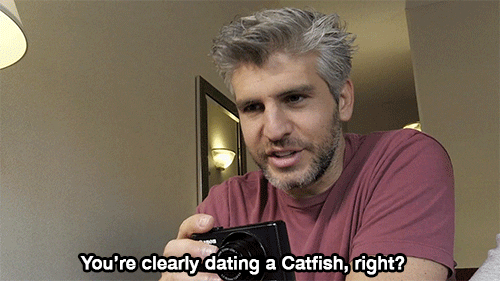This New Hiring Tactic is Driving Away Top Talent
3 min read."Catfishing" is designed to reel in top talent but they're not taking the bait...

In recruiting, you’re always wary of having the wool pulled over your eyes by a candidate. Do they really have the experience they say? Are they reliable? Could they be exaggerating their positive attributes? Well, turns out it works both ways.
From the realm of business-dating crossovers that brought you ‘ghosting’, (where companies go radio silent with candidates after an interview), comes a new way to damage your employer brand – “catfishing”.
A new study from Greenhouse has revealed that nearly 45% of candidates rejected positions after being "catfished" during the interview process.
For those unfamiliar with the term, catfishing was made popular by a reality MTV show in 2012 and is synonymous with creating a false persona to lure others into a relationship.
In the business world, this amounts to an organisation making promises they cannot keep and employer brand messaging differing from the reality of employee experience.
For example, a ‘catfishing’ organisation might:
- Showcase explicit DEI promises on their website then ask discriminatory interview questions about race, gender or marital status.
- Offer attractive workplace perks but not give employees time to use them.
- Tout a thriving company culture when there’s toxicity.
Accidental Catfishing

Unlike its dating scene equivalent, business catfishing isn’t always malicious.
With a fluid market and volatile hiring landscape, many organisations have found themselves in a period of profound transition.
While employers may believe in good faith that their employer brand messaging is accurate, between lay-offs, new hires, expansion, and restructuring, it may be the case that new changes are not yet mirrored in their employer brand or job descriptions.
For other organisations, it can be tempting to take ‘creative liberties’ with employer brand or lean too heavily on aspirations (rather than realities) to paint a picture of the current employee experience.
We get it. With such fierce competition, truthful brand messaging can feel lacklustre, while other organisations seem to offer a wealth of exciting benefits.
See this blog post to the end to learn more effective and authentic ways to stand out from the crowd.
Why is Catfishing such a bad idea for Employer Brand?
Catfishing candidates:
- Damages employer brand reputation
- Creates a resentful workforce
- Undermines company credibility
- Lowers employee retention
Businesses under the microscope
Since the rise of employee review sites such as Glassdoor, misalignment between employer brand and employee experience is no longer going undetected.
While Glassdoor is not a paragon of reliability, we know it influences candidates. A report from Fractl shows 84% of job seekers read reviews before accepting a position and a third of people have turned down an offer due to negative reviews.
Under this scrutiny, employers can no longer afford to play fast and loose with the truth of their employee experience.
Now, an occasional bad review is to be expected, but if there is a continual disconnect between the story you’re telling candidates and their perception of your organisation, it’s time to step back and reassess the key chapters.
Here are some tips to reposition your Employer Brand so you’re not caught out by the ‘catfish’ label.
Three tips to anti-catfish your Employer Brand

1. Get internal clarity:
World-class employer brand lives and dies by your ability to capture the truth about your employee experience during the research stage. If that truth has changed, it’s time to get back to basics.
If in doubt, dial up your employee-generated content and do some internal listening. This could come in the form of surveys, group workshops or one-to-ones.
Try not to settle for surface-level answers. Getting to the truth often requires more digging.
Ask thought-provoking questions such as:
- Describe your best day at work. What made it so valuable?
- If you had to convince someone not to work here, what truthful thing would you say to them?
Does your story tally up with your employees’ experiences? If not, why not? Get clarity on how your employees feel about your current messaging.
Reassess what attributes are essential to survive and thrive at your organisation, what your employees’ greatest challenges are and what employees value most in terms of purpose, impact and belonging.
Keeping the voice of your employees at the heart of your research is your best tool for accurate and authentic messaging.
2. Embrace harsh truths about your organisation

Friendly reminder: it’s okay to not have the ‘perfect’ employee experience across the board.
Aiming for a perfect experience, as with most things, will end in disappointment.
What you can create, however, is an authentic and emotive employer brand that compels talent for the right reasons.
In fact, leaning into the harsh realities of your organisation will provide better differentiation from your competition than amping up your benefits ever could.
Consider the specific adversities your employees face, and the sense of purpose and impact that make those challenges worth it.
For example:
Employees must often work long hours at your organisation BUT working for you is a great career catalyst.
Employees regularly face tough criticism BUT you seriously invest in their growth with learning and development opportunities.
Work is fast-paced and pressures are high BUT employees are given autonomy to lead and develop innovative projects.
3. Check review sites:
Employer brand is not ‘one size fits all’. It requires constant monitoring and reassessment. And your maintenance of it doesn’t go unnoticed by candidates.
A Glassdoor member survey found that people are 94% more likely to apply to positions if they witness a company publicly managing their employer branding.
For an extra layer of insight on how your messaging is measuring up, check review sites regularly to see what former and current employees are thinking.
Tread carefully when responding to negative comments. Consider the extent of truth of the sentiment behind them and approach the task consciously and empathetically.
You can use what you learn to navigate what is still true of your organisation and what may no longer be, so that you can reshape your employer brand accordingly.
Final Thoughts:
Sustaining an authentic brand involves routinely checking that your true candidate experience is in harmony with your messaging.
In this fast-moving environment, instead of ‘reeling in’ candidates, try repositioning your employer brand so that top talent swims towards you and stays with you.


